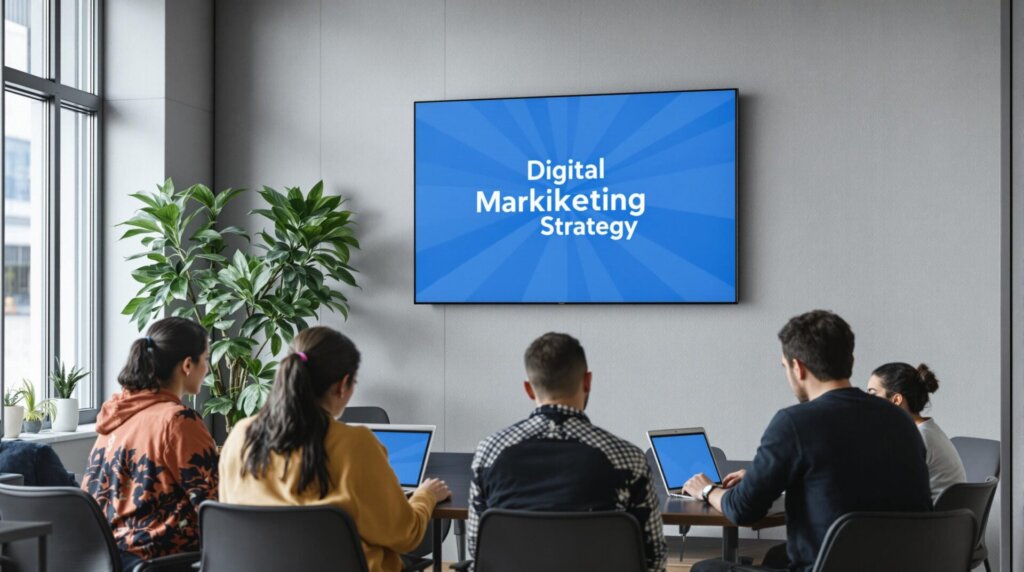Business leaders feel the pressure as growth strategies shift almost overnight. Companies using data-driven digital decisions see up to 20 percent higher growth than their competitors. Surprising, however, most organisations still cling to outdated habits that leave them lagging behind. The real winners in 2025 will be the ones who make flexibility, technology and rapid adaptation their new normal.
Table of Contents
- Understanding Modern Business Growth Strategies
- Digital Marketing Techniques For Faster Growth
- Expanding Into New Markets And Channels
- Building A Scalable And Resilient Business Model
Quick Summary
| Takeaway | Explanation |
|---|---|
| Embrace digital transformation early | Adopting data-driven decisions and digital technologies is crucial for growth and competitiveness in the evolving marketplace. |
| Cultivate strategic adaptability | Develop flexible systems to quickly respond to changing market conditions and customer expectations to maintain relevance and success. |
| Integrate marketing strategies effectively | Use advanced digital marketing techniques, including content optimization and personalized advertising, to create engaging customer experiences. |
| Focus on comprehensive market expansion | Conduct thorough research and embrace diverse channels to navigate new markets successfully while minimizing risks. |
| Build a resilient business model | Design adaptable frameworks that allow quick strategic adjustments in response to disruptions and evolving market demands. |
Understanding Modern Business Growth Strategies
Business growth strategies have evolved dramatically in recent years, demanding a more nuanced and dynamic approach to organizational development. Modern entrepreneurs must navigate complex digital ecosystems while maintaining strategic flexibility and innovation.

The Digital Transformation Imperative
The business landscape of 2025 requires a fundamental reimagining of growth strategies. Research from the National Bureau of Economic Research highlights that businesses adopting data-driven decision-making and digital technology experience significantly superior growth metrics. This transformation is not optional but essential for survival in an increasingly competitive marketplace.
Digital technologies have radically altered how businesses operate, communicate, and generate value. Companies must now integrate advanced analytics, artificial intelligence, and strategic digital platforms into their core operational frameworks. This means moving beyond traditional linear growth models and embracing more adaptive, technology-enabled approaches.
Strategic Adaptability as a Core Competency
Successful business growth now demands unprecedented levels of strategic adaptability. Organizations must develop robust systems that can quickly pivot in response to market changes, technological disruptions, and evolving customer expectations. This requires building flexible infrastructures, cultivating a culture of continuous learning, and maintaining agile operational processes.
Entrepreneurs must think holistically about growth, understanding that it encompasses more than just financial metrics. Modern growth strategies integrate technological innovation, human capital development, customer experience optimization, and sustainable business practices.
Integrated Approach to Business Expansion
Growth is no longer a siloed function but an integrated organizational strategy. Businesses must synchronize multiple dimensions: technological infrastructure, talent development, market positioning, and customer engagement. This holistic approach demands cross-functional collaboration and a strategic mindset that views growth as a comprehensive ecosystem.
By developing strategic insights into digital marketing approaches, businesses can create more targeted and effective growth strategies. The key is understanding that modern business growth is about creating value through intelligent, adaptive, and technologically empowered approaches.
The most successful organizations in 2025 will be those that can blend technological innovation, human creativity, and strategic thinking into a cohesive growth strategy. This requires continuous learning, rapid experimentation, and a willingness to challenge traditional business paradigms.
To help clarify the major components of modern business growth, the following table summarises three core pillars that organisations must integrate:
| Pillar | Focus Area | Example Strategies |
|---|---|---|
| Digital Transformation | Technology & Data Analytics | AI integration, Digital platforms, Real-time analytics |
| Strategic Adaptability | Flexibility & Agile Operations | Rapid pivots, Continuous learning, Agile frameworks |
| Integrated Expansion | Organisational Collaboration & Market Reach | Cross-functional teams, Omnichannel engagement |
Digital Marketing Techniques for Faster Growth
Digital marketing has become a critical driver of business growth, transforming how companies connect with customers and generate revenue. In 2025, successful businesses must leverage sophisticated digital marketing techniques that go beyond traditional advertising approaches.
Strategic Content and SEO Integration
Research from the Economic and Business Horizon journal emphasizes the importance of comprehensive digital marketing strategies. Businesses must develop content that not only attracts audiences but also delivers genuine value. This means creating high-quality, targeted content that addresses specific customer pain points while optimizing for search engine visibility.
Search engine optimization remains a powerful growth technique. By understanding keyword dynamics, creating authoritative content, and building strategic backlink networks, businesses can improve their online visibility. This approach goes beyond simple keyword stuffing and requires a nuanced understanding of user intent and search algorithms.
Advanced Digital Advertising and Targeting
An empirical study in the International IT Journal of Research highlights the transformative potential of integrated digital marketing approaches. Modern businesses must utilize sophisticated targeting techniques across multiple platforms. This includes leveraging data analytics to create highly personalized advertising campaigns that reach specific audience segments with precision.
Social media advertising, programmatic ad buying, and retargeting strategies have become essential tools for rapid business growth. By using advanced tracking and analysis tools, companies can optimize their advertising spend and achieve significantly higher conversion rates.
Emerging Technologies in Marketing

Artificial intelligence and large language models are revolutionizing digital marketing capabilities. Research exploring LLM potential in marketing management demonstrates how these technologies can enhance personalization, generate real-time customer insights, and automate complex marketing processes.
Businesses can now use AI-powered tools to generate targeted content, predict customer behavior, and create more engaging marketing experiences. These technologies enable more dynamic and responsive marketing strategies that adapt in real-time to changing market conditions.
Learn more about selecting the right digital marketing partners to accelerate your growth strategy. The most successful businesses will be those that can seamlessly integrate cutting-edge technologies with human creativity and strategic thinking.
Digital marketing in 2025 is not just about reaching customers but creating meaningful, personalized experiences that drive genuine engagement and sustainable business growth. Companies must remain agile, continuously learning and adapting their digital marketing techniques to stay competitive in an increasingly complex digital ecosystem.
To provide a clearer view of advanced digital marketing techniques, the following table outlines key strategies alongside their primary benefits:
| Technique | Description | Main Benefit |
|---|---|---|
| Content & SEO Integration | High-value, optimised content for search engines | Increased visibility & engagement |
| Personalised Advertising | Data-driven, targeted ad campaigns | Higher conversion rates |
| Social Media Advertising | Campaigns on major networks | Broader, more engaged reach |
| Programmatic Ad Buying | Automated buying based on data and analytics | Cost efficiency, better targeting |
| AI-Generated Content | Content created using artificial intelligence | Improved relevance, scalability |
Expanding into New Markets and Channels
Business growth in 2025 demands strategic market expansion that goes beyond traditional geographic boundaries. Companies must develop sophisticated approaches to identify, penetrate, and succeed in emerging market opportunities across diverse channels and platforms.
Strategic Market Development Approaches
Research from OpenStax highlights the critical importance of understanding regional differences when exploring new market territories. Successful market expansion requires comprehensive research, cultural intelligence, and adaptive strategies that can navigate complex international business landscapes.
Businesses must conduct thorough market analysis, evaluating potential opportunities through multiple lenses: demographic trends, economic indicators, technological infrastructure, and consumer behavior patterns. This multifaceted approach ensures more precise targeting and reduces potential expansion risks.
Diversification and Channel Innovation
According to Harvard Business Review, exceptional business growth emerges from redefining profit drivers and reconfiguring business units. Modern organizations must think beyond linear expansion models, embracing innovative strategies that create unique value propositions across different market segments.
Diversification strategies should include exploring digital channels, emerging technology platforms, and non-traditional market niches. This might involve developing hybrid business models that combine physical and digital experiences, creating more flexible and responsive market engagement approaches.
Technology-Enabled Market Penetration
Technology plays a pivotal role in market expansion strategies. Advanced data analytics, artificial intelligence, and machine learning tools enable businesses to identify and assess potential market opportunities with unprecedented precision. Companies can now map complex market dynamics, predict consumer trends, and develop targeted expansion strategies.
Discover advanced customer relationship management techniques that support seamless market expansion efforts. Successful businesses will leverage sophisticated technological tools to create adaptive, responsive market entry strategies.
Effective market expansion in 2025 requires a holistic approach that combines strategic thinking, technological innovation, and a deep understanding of global business ecosystems. Organizations must cultivate agility, continuously learn from market feedback, and maintain a flexible approach to growth that can rapidly adjust to changing economic landscapes.
Building a Scalable and Resilient Business Model
Creating a business model that can withstand disruptions while enabling consistent growth has become crucial for organizational survival in 2025. Modern enterprises must design flexible frameworks that can adapt quickly to changing market conditions and unexpected challenges.
Frameworks for Organizational Resilience
Research from the Schmalenbach Journal of Business Research developed a comprehensive framework identifying 11 critical factors for maintaining organizational resilience. These factors go beyond traditional risk management, emphasizing the importance of adaptive capabilities, strategic flexibility, and proactive organizational learning.
Businesses must develop systems that can rapidly reconfigure resources, pivot operational strategies, and respond dynamically to external pressures. This requires building robust internal communication channels, fostering a culture of continuous innovation, and maintaining financial flexibility that allows quick strategic adjustments.
Scalable Business Model Strategies
Insights from the MIT Sloan Management Review highlight five critical patterns for achieving scalable business models. These include expanding distribution channels, removing traditional capacity constraints, strategically outsourcing capital investments, creating multifunctional partner relationships, and establishing platform-based business models.
Successful scalability requires businesses to think beyond linear growth models. Organizations must design modular, interconnected systems that can expand or contract based on market demands. This involves leveraging technology, creating flexible workforce structures, and developing adaptive operational frameworks.
The following table summarises five patterns for scalable business models referenced in the content for easier comparison:
| Pattern | Primary Focus | Example Approach |
|---|---|---|
| Expand Distribution Channels | Reach broader customer base | Add online, retail, and partner sales |
| Remove Capacity Constraints | Eliminate bottlenecks | Automate operations, scale cloud services |
| Outsource Capital Investments | Reduce fixed costs | Use third-party logistics or leasing |
| Multifunctional Partner Relationships | Strengthen networks & resources | Strategic alliances, co-development |
| Platform-Based Models | Create value through ecosystems | Launch digital platforms/apps |
Holistic Resilience and Preparedness
Research from the California Management Review presents a comprehensive approach to building resilient small and medium enterprises. The study emphasizes the importance of entrepreneurial leadership, technological innovation, and collaborative network development as key drivers of organizational preparedness.
Entrepreneurs must cultivate leadership approaches that embrace uncertainty, encourage experimental thinking, and maintain strategic agility. This involves developing robust digital infrastructures, exploring advanced operational management systems, and creating organizational cultures that view change as an opportunity rather than a threat.
Building a resilient business model in 2025 is not about predicting the future but creating organizational capabilities that can effectively navigate uncertainty. Successful businesses will be those that can balance strategic planning with adaptive flexibility, leveraging technology, human creativity, and innovative thinking to transform challenges into growth opportunities.
Frequently Asked Questions
What are the key business growth strategies for 2025?
Successful growth strategies for 2025 include embracing digital transformation, cultivating strategic adaptability, integrating marketing approaches, focusing on comprehensive market expansion, and building a resilient business model.
How can digital transformation impact business growth?
Digital transformation can significantly enhance business growth by enabling data-driven decision-making, improving operational efficiency, and creating new opportunities for customer engagement through advanced technologies.
What role does strategic adaptability play in business success?
Strategic adaptability is crucial for businesses to respond swiftly to market changes and customer expectations, ensuring they remain competitive. This involves flexible systems and a culture of continuous learning.
What digital marketing techniques should businesses utilise for faster growth?
Businesses should implement advanced digital marketing techniques such as strategic content and SEO integration, personalised advertising, social media promotion, and leverage emerging technologies like AI to enhance customer engagement.
Ready to Achieve Real Growth in 2025?
You have just learned that navigating business growth in 2025 means moving beyond outdated habits and embracing new digital strategies. Does trying to adopt digital transformation, advanced marketing, and flexible business models feel overwhelming? Many entrepreneurs struggle to actually put these modern techniques into practice and see proven results. If you are determined to avoid being left behind, it is time to join a platform where real innovation and support meet.

Take the first step and explore Smart Business 100. Here you will discover digital marketing solutions and operational resources built specifically for businesses like yours. From expert digital marketing support to actionable business growth tools, every solution is crafted to help you move quickly towards lasting success. Start now to secure your advantage in the new digital landscape—visit Smart Business 100 and see how you can unlock sustainable growth today.


